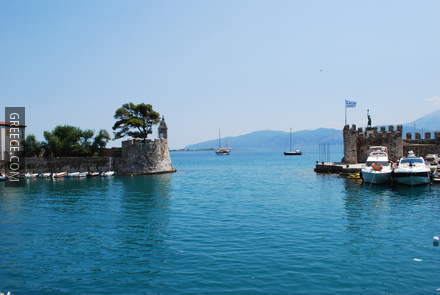General Information on Nafpaktos
Nafpaktos is a small historical and picturesque town with good clean beaches, on the Corinthian Gulf. Built between Antirrio and the estuary of Mornos river, it is one of the oldest Greek cities, having prospered in the past and being linked to many historical events. The old town has kept its own style and traditional feel. Everywhere you look, there is beauty, harmony, serenity. You can easily discover small or big traditional particularities even in the cement and the antennae of modern buildings.
History of Nafpaktos
Nafpaktos is first mentioned around 1104 BC, when the Dorians came here to construct basic rafts, and was under the rule of Lokrioi. In 454 BC, Athenians pushed them away and let people from Messinia settle the area. In 426 BC, Athenian general Dimosthenis marched against the Aetolians, who won and repelled his troops. However, Spartian general Eurylohos, helped by Lokrioi, marched all the way to Nafpaktos. In 369 BC, after the Athenians lost in Aigos rivers, Messinians evacuated the city and left for Sicily. Nafpaktos went back to the hands of Lokrioi. In 350 BC, Macedonian leader Phillip the Second gave the city to Aetolians. Starting in 338 BC, Nafpaktos became the centre of the Aetolian Confederation and later turned into the capital of the area. In 191 BC, Romans lay siege to the city, but were finally forced to sign a truce with Aetolians.
During the Byzantine era, Nafpaktos was an important stop of travellers towards Italy and Constantinople. The city fortress was radically repaired during Justinian's rule, but in 553 AD, the city was hit by an earthquake. After the fall of Constantinople to the Crusaders, the city was annexed to the Epirus Despotate for almost a century (1204-1294). In 1407, it passed to Venetian hands, before finally being conquered by the Turks in 1499.
In 1571, the famous Naval Battle of Nafpaktos (or Lepanto) took place. Although the winning Christians managed to destroy the naval Turkish force, the city finally returned to Turkish hands after the Karlovich Treaty. However, the importance of the battle lies in the fact that the naval Turkish force was unable to move towards the rest of Europe.
In 1821, the inhabitants participated in the Revolution for Independence. The city was finally liberated on 18 April 1829, when Andreas Miaoulis blockaded the port, forcing the Turks to surrender.
Beaches in Nafpaktos
The area of Nafpaktos has many nice and clean beaches and have been awarded the EU Blue Flag award. They have all necessary facilities and offer many services, satisfying all needs a visitor may have.
In some of these like Psani and Grimbovo, plane trees grow right next to the sea. Other choices are Monastiraki, which is at a distance of 12 km. east of Nafpaktos, and Platinitis, at a distance of 7 km. southwest of Nafpaktos.
Top Things to Do in Nafpaktos
Venetian castleA very well-preserved Venetian castle at the top of the hill, this is one of the most beautiful in Greece. The castle proudly overlooks the city and the bay of Patras. Greeks, Turks, Venetians, Englishmen, pirates, they all used the castle as their base and somehow influenced its architecture.
The picturesque small church of Prophet Ilias can be found here in a wooded area. Inside the castle, the remains of a Turkish mosque and Turkish baths have been conserved. Next to it there is Tzavelas' House.
The Harbour was part of the fortifications of the city and is surrounded by Venetian towers and ramparts. Today, it is the meeting point of the city. Enjoy your coffee or lunch at one of the many cafes and restaurants near the harbour.
Monastery of Agios Ioannis Prodromos: A monastery with interesting frescos 10 km. north of Nafpaktos.
Papacharalambio library and the Farmakis collection: You can see heirlooms from the Greek War of Independence of 1821.
Papacharalambia: Every July, the "Papacharalambia" celebration is held. It includes both athletic and cultural events. Greek and other foreign groups participate in drama performances in the castle.
Rio-Antirio bridge: The largest bridge in Greece, very nice at night.
Make sure to visit the surrounding mountains, as their beauty is divine. On the foot of Pindos, a number of small villages await for you, tucked within forests of oaks, spruces, beeches, plane and chestnut trees. The old houses of the villages, mostly built of slate, are particularly interesting architecturally, combining the traditional element with influences from Epirus. There is much more, though; old forest paths, rich fauna, water springs, rivers, waterfalls, lakes, chestnuts, wine, festivities, all is harmoniously combined here.
How to Reach Nafpaktos
Just two hours away from the Greek capital, there are many bus routes connecting Nafpaktos daily with many places around Greece, including Athens and Thessaloniki.
Weather in Nafpaktos
Soft winters and cool summers. Increased precipitation (for Greek standards), short periods of summer aridity and a great sun.
Map of Nafpaktos
 Athens Photos
Athens Photos
 Santorini Photos
Santorini Photos
 Crete Photos
Crete Photos
 Meteora Photos
Meteora Photos
 Corfu Photos
Corfu Photos

































_160x80.jpg)







